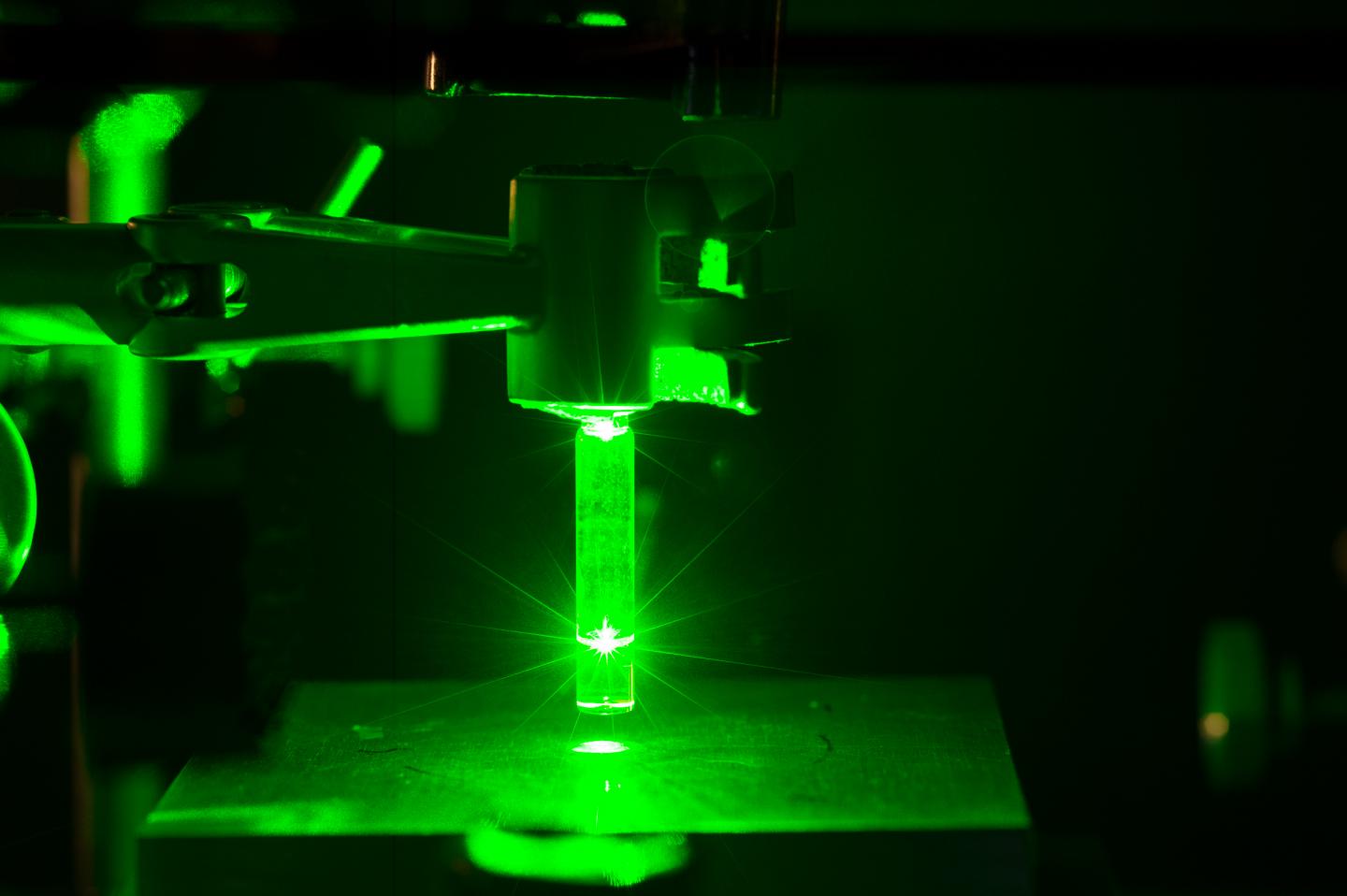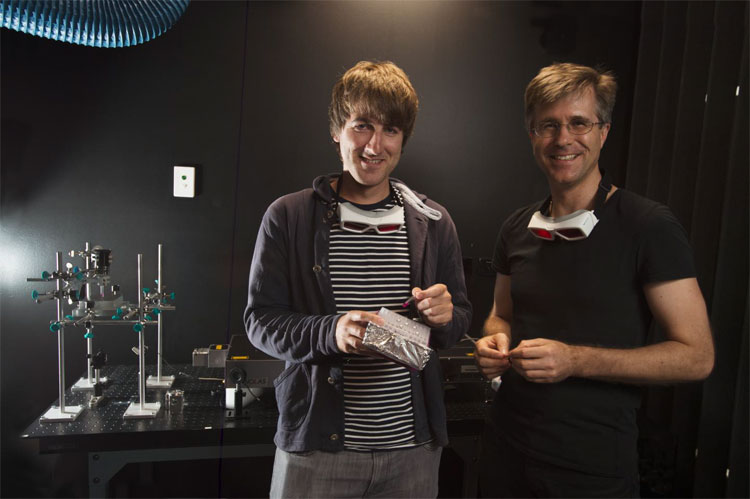
Visible Light Controls Chemical Reaction Pathways, Could Be UV Alternative
source:Photonics
release:Nick
keywords: visible colored light Green laser Chemical Reaction
Time:2017-12-07
BRISBANE, Australia, Dec. 4, 2017 — A technique has been developed that modulates visible colored light, enabling it to control the reactions of chemical coupling agents needed to make industrial materials. Researchers showed that the modulation of the reactivity by light could be reversed, and that individually addressable reaction pathways could be repeatedly accessed. This technique could enable use of visible rather than UV light for future industrial applications in chemical and advanced manufacturing.
Researchers from Queensland University of Technology (QUT), Karlsruhe Institute of Technology (KIT) and Ghent University used green laser light to control the reactivity of triazolinediones (TADs). Under green light the TADs stopped reacting; when the light was switched off, the TADs became highly reactive again. Researchers repeated the light-switching process multiple times. The experiments showed that the visible light-induced photopolymerization of TADs led to a quantitative photodeactivation, providing a selective on- and off-switch for their thermal reactivity.

Researchers used a green laser to modulate the reactivity of triazolinediones (TADs), powerful chemical coupling agents. Courtesy of QUT.
based on careful selection of a thermal TAD-based reaction, the team designed a reaction manifold using light as a gate to selectively switch between a thermally and photochemically activated reaction channel, providing light-induced selectivity of the reaction outcome.

Professor Christopher Barner-Kowollik, right, and researcher Hannes Houck. Courtesy of QUT.
Professor Christopher Barner-Kowollik from QUT said that UV light, which is more harmful than visible light, is frequently used in industry to drive chemical processes. This is in contrast to natural processes.
“For plants, visible light plays a critical role in chemical processes. Trees harvest light during the day and use this as an energy source to grow, releasing oxygen in the process. At night, however, when light is no longer available, the chemical process is altered and plants release carbon dioxide.
“We've been inspired by such natural processes and designed a completely light-switchable chemical reaction system for the first time,” Barner-Kowollik said.
The research team believes that their system could be used to create light-sensitive materials for 3D laser lithography, allowing printing of very small structures that could be used for computer chip fabrication.
“Here, due to the so-called light diffraction limit, radiation with short wavelengths — which is very harsh UV light — is used. But what if we could use visible light to reversibly switch certain chemical processes and get around the light diffraction limit and print very, very small structures, for example five nanometers wide?” said Barner-Kowollik. “Being able to switch chemical reactivity within 3D laser lithography could revolutionize chip printing, and make it cheaper, simpler and safer . . . potentially the system we have devised with visible light as a chemical deactivation mechanism could provide an avenue to achieve that.”
Researchers from Queensland University of Technology (QUT), Karlsruhe Institute of Technology (KIT) and Ghent University used green laser light to control the reactivity of triazolinediones (TADs). Under green light the TADs stopped reacting; when the light was switched off, the TADs became highly reactive again. Researchers repeated the light-switching process multiple times. The experiments showed that the visible light-induced photopolymerization of TADs led to a quantitative photodeactivation, providing a selective on- and off-switch for their thermal reactivity.

Researchers used a green laser to modulate the reactivity of triazolinediones (TADs), powerful chemical coupling agents. Courtesy of QUT.
based on careful selection of a thermal TAD-based reaction, the team designed a reaction manifold using light as a gate to selectively switch between a thermally and photochemically activated reaction channel, providing light-induced selectivity of the reaction outcome.

Professor Christopher Barner-Kowollik, right, and researcher Hannes Houck. Courtesy of QUT.
Professor Christopher Barner-Kowollik from QUT said that UV light, which is more harmful than visible light, is frequently used in industry to drive chemical processes. This is in contrast to natural processes.
“For plants, visible light plays a critical role in chemical processes. Trees harvest light during the day and use this as an energy source to grow, releasing oxygen in the process. At night, however, when light is no longer available, the chemical process is altered and plants release carbon dioxide.
“We've been inspired by such natural processes and designed a completely light-switchable chemical reaction system for the first time,” Barner-Kowollik said.
The research team believes that their system could be used to create light-sensitive materials for 3D laser lithography, allowing printing of very small structures that could be used for computer chip fabrication.
“Here, due to the so-called light diffraction limit, radiation with short wavelengths — which is very harsh UV light — is used. But what if we could use visible light to reversibly switch certain chemical processes and get around the light diffraction limit and print very, very small structures, for example five nanometers wide?” said Barner-Kowollik. “Being able to switch chemical reactivity within 3D laser lithography could revolutionize chip printing, and make it cheaper, simpler and safer . . . potentially the system we have devised with visible light as a chemical deactivation mechanism could provide an avenue to achieve that.”
MOST READ
- RoboSense is to Produce the First Chinese Multi-beam LiDAR
- China is to Accelerate the Development of Laser Hardening Application
- Han’s Laser Buys Canadian Fiber Specialist CorActive
- SPI Lasers continues it expansion in China, appointing a dedicated Sales Director
- Laser Coating Removal Robot for Aircraft
PRODUCTS
 FISBA exhibits Customized Solutions for Minimally Invasive Medical Endoscopic Devices at COMPAMED in
FISBA exhibits Customized Solutions for Minimally Invasive Medical Endoscopic Devices at COMPAMED in New Active Alignment System for the Coupling of Photonic Structures to Fiber Arrays
New Active Alignment System for the Coupling of Photonic Structures to Fiber Arrays A new industrial compression module by Amplitude
A new industrial compression module by Amplitude Menhir Photonics Introduces the MENHIR-1550 The Industry's First Turnkey Femtosecond Laser of
Menhir Photonics Introduces the MENHIR-1550 The Industry's First Turnkey Femtosecond Laser of Shenzhen DNE Laser introduced new generation D-FAST cutting machine (12000 W)
more>>
Shenzhen DNE Laser introduced new generation D-FAST cutting machine (12000 W)
more>>
